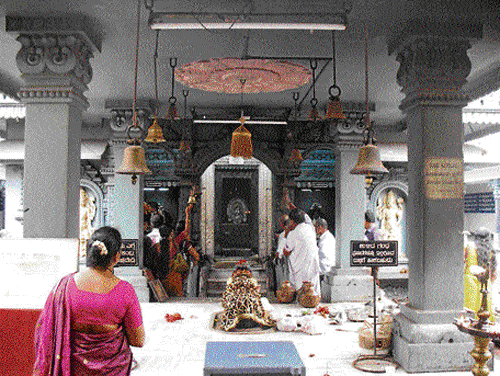
Surrounded by the Pancha Gangavalli, Kalaghar rivers and the Arabian Sea on three sides is the beautiful city of Kundapura. Considered to be a prominent port city in history, it is said to have seen the reign of the Alupas, Kadambas, Chalukyas, Hoysalas, the Vijayanagara rulers, and Tippu Sultan with each contributing to its culture and economy before finally coming under the British rule. Positioned as an important taluk in Udupi district, it is also home to many religious and tourist destinations, both famous and relatively unknown. Prominent amongst them is the Kundeshwara temple.
The temple is said to have been constructed by Kundavarma of the Alupa dynasty who ruled this region around 10-11th Century AD, also lending the town its name. Temple inscriptions dating back to 13th Century AD, citing the town’s name, confirm this. The main deity is Kundeshwara or Lord Shiva in the form of a linga that is partially visible, said to be about 4-ft tall, while the remaining is buried underneath. The sanctum sanctorum is of black stone and is located at the centre. The entire temple has been renovated, in a slight deviation from the traditional coastal architectural style. Lord Ganesha and Goddess Parvathi are also worshipped here. A pond situated beside the temple with a statue of Lord Shiva performing penance provides a calm atmosphere.
Besides the Kundeshwara temple, several other temples are said to be found in and around the town. There was also a mention about historical Portuguese and Dutch settlements, a redoubt built by Hyder Ali etc. though we were not able to locate any of them. Interesting historical places are often missed or forgotten due to lack of information. We then decided to move onto the famed Maravanthe beach. We learnt that express buses that went up to Byndoor happened to stop at the Maravanthe beach. But boarding a local bus due to slight communication gap turned out to be nerve-wracking.
The conductor’s yell of “beach” put an end to the misery we endured as we disembarked.
The first thing that caught our sight was the closeness of the sea to the road. Waves lashing with a steady rhythm onto the beach left us spellbound. With trees and wonderful greenery on the other side of the road and along the beach, this place was indeed the one that we had heard a lot about. Except for one small thing. Something was definitely amiss.
Despite the steady stream of vehicles, none seemed to stop here. Enquiring at the juice shop nearby, we realised that we had alighted at the Trasi beach, commonly referred to as Beach by the locals. This is a little before than Maravanthe beach, which is about two kilometres away.
Trasi beach is beautiful with its pure white sand and cool waters. It is a delight to wade in the waves and take in the scenic beauty and cool breeze the place has to offer. Suitable infrastructure has been provided. This beach is also said to be a haven for turtles which lay their eggs along here during the season.
Beach erosion is very high as one can feel the feet being dragged along with the sand by the retreating waves. With the highway being just about 10-15 feet away, a retaining barrier of rocks has been placed all along to act as a buffer. As one walks along the highway towards Maravanthe from Trasi, one can notice the lush greenery and tree cover on the right slowly thinning out to reveal a quiet flowing river in the background. The tree cover eventually disappears revealing the Sowparnika River in all her magnificence as she aligns herself parallel to the highway until both the river and the sea are separated only by the width of the highway and its retaining wall.
This is a rare spectacle and the only such one occurring in the entire country.
Enthralled by this heavenly creation of Nature, we stood mesmerised, watching the quiet Sowparnika flow, oblivious of the tempestuous sea. Having visited during the Monsoon, we were told that during the peak Monsoon, one gets to see the sea unleash its full wrath with the waves spilling onto the highway. Walking away with a heavy heart, we headed towards the Maharaja Swamy Shree Varaha Temple.
Said to be built in the 10th Century AD, the temple is said to be one of the few temples in the world which worships Varaha, the incarnation of Lord Vishnu as a boar. Located on the banks of the Sowparnika, this temple has the sanctum sanctorum divided into three segments with Vishnu or Janardhana, Narasimha and Varaha as the three deities with Varaha being the main deity. The tortoise, crocodile and the fish are also worshipped here.
How to get there
Kundapura is about 40 kilometres from Udupi. Frequent bus service is available between both cities. Trasi beach is about 15 kms from Kundapura and the buses going to Byndoor are known to stop at Trasi as well as Maravanthe, both being about two kilometres apart on the same highway.